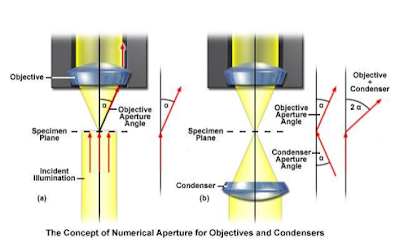Microscope - Principle and limit of Resolution
A microscope is an instrument used to see objects that are too small for the naked eye. The science of investigating small objects using such an instrument is called microscopy. Microscopic means invisible to the eye unless aided by a microscope. Microscopes have long been essential tools of cell biologists. This tutorial provides a brief overview of types of microscopes commonly used in biological studies and general techniques for preparing specimens for the various types of microscopy. Microscopes are specialized optical instruments designed to produce magnified visual or photographic (including digital) images of objects or specimens that are too small to be seen with the naked eye. Collectively, this varied group of tools includes not only multiple-lens (compound microscope) designs featuring objectives and condensers, but also consists of very simple single-lens instruments that are often hand-held, such as a photography loupe or common magnifying glass.
Principle
The basic principle of microscope to form an enlarge image of specimen via combination of different type of lenses ( glass lenses in light microscope or electromagnetic lenses in electron microscope).
Numerical aperture
The numerical aperture of a microscope objective is the measure of its ability to gather light and to resolve fine specimen detail while working at a fixed object (or specimen) distance. In order to enable two objectives to be compared and to obtain a quantitative handle on resolution, the numerical aperture, or the measure of the solid angle covered by an objective is defined as:
Numerical Aperture (NA) = η • sin(α)
where α equals one-half of the objective's opening angle and η is the refractive index of the immersion medium used between the objective and the cover slip protecting the specimen (η = 1 for air; η = 1.51 for oil or glass).
Resolution
The resolution of an optical microscope is defined as the shortest distance between two points on a specimen that can still be distinguished by the observer or camera system as separate entities. An example of this important concept is presented in the figure below, where point sources of light from a specimen appear as Airy diffraction patterns at the microscope intermediate image plane.
Limit of resolution
The limit of resolution is defined as the minimum distance between two point that allow for their discrimination as two separate point.
The limit of resolution of light microscope depend on 3 factor
1. wavelength of light
2. angular apperture
3. the refractive index of medium
limit of resolution (d) = lamda / 2NA
There are various type of microscopy which are here
1.light microscopy
2.electron microscopy
3.confocal microscopy
4.floroscent microscopy
